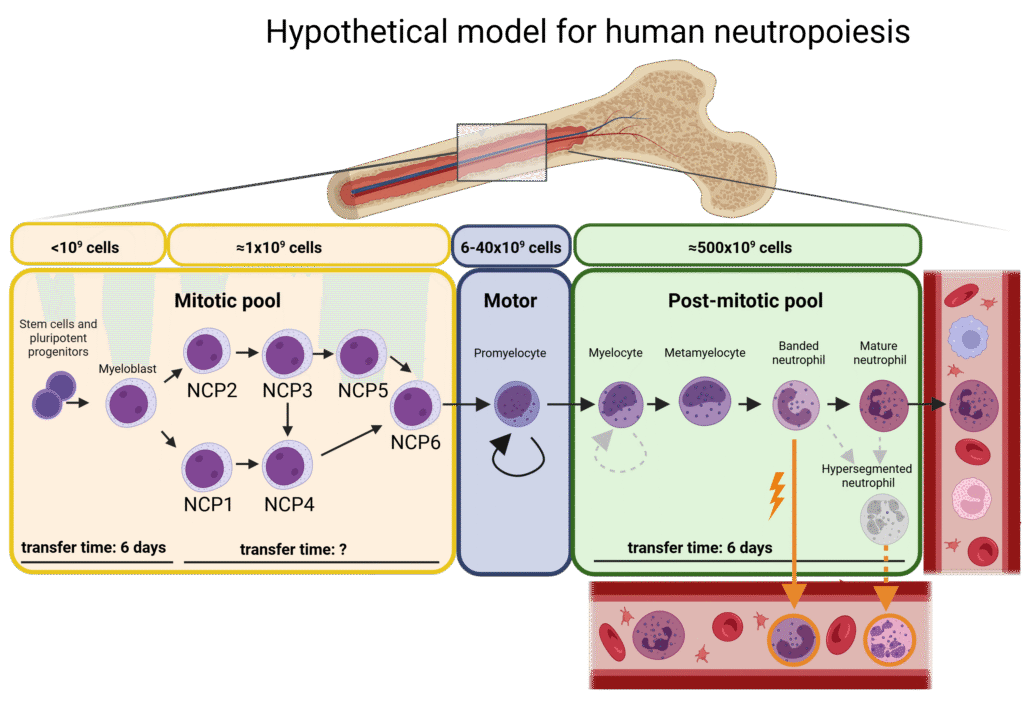Understand human phagocyte dynamics and function from their birth to their death in health and inflammation. These insights can be used to predict the status of a disease and susceptibility to infectious and immune mediated diseases.

Our team

Our Science

Homeostasis
In order to understand how phagocyte dynamics change in disease it is pivotal to first understand their functions in homeostasis. We use cutting edge techniques such as deuterated glucose labeling in humans to determine phagocyte production, migration and death in blood, bone marrow and peripheral tissues.
Physical trauma
Upon physical trauma neutrophils can quickly recognize and signal damage as well as combat penetrating pathogens. A fully automated flow cytometer called the AQUIOS enables the quick measurement of neutrophil subtypes and activation without the requirement of trained personnel. These insights can predict disease severity, the susceptibility to infections and aid to personalize treatment.


Lung inflammation
Our lab investigates eosinophils, monocytes and neutrophils as first responders in (sterile) inflammation. These phagocytes can quickly recognize and signal danger as well as combat pathogens. Inflammatory diseases the lab focuses on are (long) COVID, asthma, COPD and cystic fibrosis. We can use these fast responding cells to biomonitor the inflammatory status of the patient even at point-of-care using a fully automated flow cytometer called the AQUIOS. These insights can predict the status of a disease, the susceptibility to infections and aid to personalize treatment.
Lung transplantation
During lung transplantation the surgery in the donor and the acceptor provoke an inflammatory response. We aim to investigate whether innate immune cell monitoring of the donor lung and acceptor blood can predict acute rejection and BLAD before clinical symptoms appear.


Microplastics
Microplastics have been detected in human blood, urging the need to study their health effects. Our lab studies the response of innate immune cells to microplastics in vivo in mice and in vitro using primary human immune cells.
Our tools
Glucose labeling of human innate immune cells
In order to unravel human phagocyte dynamics in both health and inflammation we use deuterated glucose labeling to determine phagocyte production, maturation, migration and death in blood, bone marrow and peripheral tissues


Intravital 2PM microscopy
We visualize phagocyte migration longitudinally in living mice using 2-photon microscopy. Mice are anesthetized and fluorescent immune cells can be captured in many different organs. When imaging skin or organs behind imaging windows, mice can wake up after the imaging session and monitored longitudinally.
Microfluidics and 3D gels
We visualize human phagocyte migration in 3D matrices and microfluidics. For instance to understand whether the typical lobular nucleus of a neutrophil and eosinophil aids in squeezing through narrow pores, but also to compare migration of different neutrophil subsets. In addition, we visualize how phagocytes migrate towards bacteria versus microplastics and investigate whether the phagocytosis of microplastics influences human neutrophil migration.


Automated point-of-care flow cytometry
We have now placed the fully automated AQUIOS flow cytometer in a van! This enables us to measure the innate immune status at the patients’ doorstep.
News
- Emma will defend her thesis April 16 2026 at 14.15
- Simon and Berber presented their data at the ERS in the RAI in Amsterdam this September
- Aquios in the bus is ready to drive!
Get in touch
Join our team
- Vacancies
- Internships

“To get real diversity of thought, you need to find the people who genuinely hold different views and invite them into the conversation.” – Adam Grant
